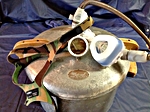Jay Aitchsee wrote:ajack wrote:You are going to feel very silly when the penny drops. Notice that other long timers aren't backing you?
An obstructive apnea is an above 90% flow limit for 10 seconds or more. You can't have an OA without a flow limit, it's it definition. It obviously doesn't stop being a flow limit, when the event is called an OA
AJack, I agree with PR that Flow Limitations as a metric are distinct from hypopneas and apneas. I will try to explain why when I have a little more time. In the meantime, here's the AASM scoring rules:
https://go.aastweb.org/Resources/journa ... events.pdf
ajack wrote:that isn't pr claim. PR is saying that they aren't a flow limit.
one type hypopnea definition is a flow limit of more than 30% [emphasis added]
I was using
https://www.ncbi.nlm.nih.gov/pmc/articles/PMC3459210/
Rules for Scoring Respiratory Events in Sleep: Update of the 2007 AASM Manual for the Scoring of Sleep and Associated Events
Very quickly:
No, the rule states (in part):
(If) The peak signal excursions drop by ≥ 30% of pre-event baseline using nasal pressure (diagnostic study), PAP device flow (titration study), or an alternative hypopnea sensor.
It does not mention Flow Limitations or flow limit.
Your argument has been about semantics, definitions, and usage of terms.
ResMed scores machine detected Flow Limitations based on the degree of flattening of the inspiratory Flow Wave. The AASM does not score Flow Limitations by the degree of flattening, but does state:
Flattening of the inspiratory portion of the flow waveform provides evidence of airflow limitation and increased upper airway resistance.
But, AASM scored hypopneas
may, or may not, exhibit
"flattening of the inspiratory portion of the nasal pressure (or PAP device flow) waveform".
BTW, here's a snip containing an obstructive apnea. Notice there is no Flow Limitation scored (there is one of 0.07 starting at 01:59:30).












